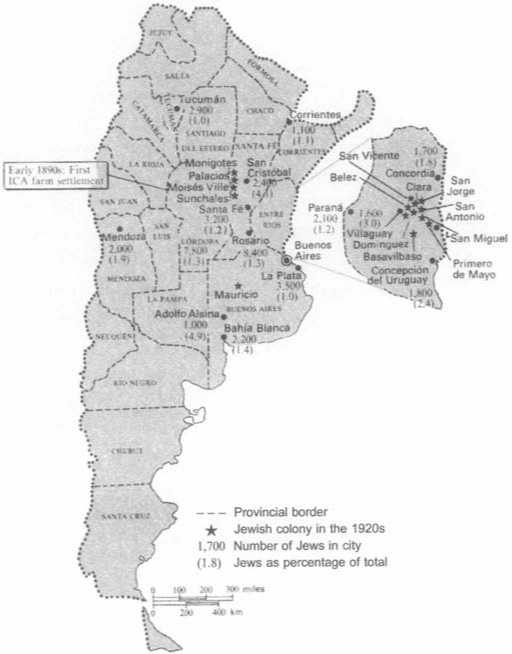
The settlement of Jews in Argentina was stimulated by the activities of the Jewish Colonization Association (ICA), founded in 1891. ICA established agricultural colonies, mostly in the provinces of Entre Rios and Santa Fe. Although in the 1930s, there were only 20,000 to 30,000 Jewish farmers, the ICA initiative brought many Jewish immigrants to Argentina; they settled in cities, especially in the capital, Buenos Aires. Gradually, Buenos Aires attracted most Argentinian Jews, including those living in the provincial cities or in the colonies. In the early twentieth century, two-thirds of Argentinian Jews lived in the provinces, especially Entre Rios; by 1960, four-fifths lived in Greater Buenos Aires. In 1964, only about 800 Jewish families were engaged in agriculture, in the colonies.
Although in principle the Jews were citizens with full rights, in practice there was a strong antisemitic movement in Argentina, influenced by European traditions. There were anti-Jewish riots in 1919 and problems in later years as well, reflecting the country’s internal tensions. The organization of Argentinian Jewry was strongly influenced (and dominated) by the Buenos Aires community. The Jews established two umbrella organizations. One was the Delegacion de Aso-ciaciones Israelltas Argentinas (DAIA), founded in 1933, whose purpose was to fight antisemitism and represent the community before the authorities. The other, Va’ad ha-Kehillot, organized in 1952, was based on the Ashkenazic community of Buenos Aires, the Asocia-Cion Mutual Israelita Argentina (AMIA). Va’ad ha-Kehillot became responsible for a broad spectrum of Jewish activities of a social, educational, religious, and cultural character. The Zionists had considerable influence in both bodies, and their representation was along the lines of the Zionist party structure.
From the 1960s, Argentina underwent much political and social unrest. This affected the Jewish community. The number of Jews in the country decreased significantly in the second half of the century, in part because of their low birth rate, and in part because of emigration.
The Jews in Buenos Aires In the second half of the twentieth century, Buenos Aires was the largest Jewish center in Latin America. Its development was similar to that of many other Jewish communities in the New World: beginnings in the nineteenth century, but real growth only toward the end of the century, with the immigration of a large number of Jews from Eastern Europe.
The way the united (Ashkenazic) Jewish community of Buenos Aires (AMIA) came into being, although it had precedents, was curious in twentieth-century conditions: it grew out of a burial society (hevra kadisha) formed in the mid-1890s that over the years assumed a wide range of other Jewish communal functions, to the point where it performed nearly all of them in the city. The result was a much tighter centralization of Jewish institutions under one umbrella than occurred in most other twentieth-century Jewish centers. Since in the 1960s, about 80 percent of all Argentinian Jews lived in Buenos Aires, AMIA influenced the Jewish life of the majority of the country’s Jews. The Sephardic community of Buenos Aires had separate Jewish institutions.
Buenos Aires Jewry was known for its rich Jewish cultural life. Although the Zionists dominated AMIA, there was an important group of Yiddish intellectuals, many of whom were associated with the Bund.
The size of Buenos Aires Jewry reached its peak in 1960. Thereafter, the number decreased steadily.




 World History
World History









